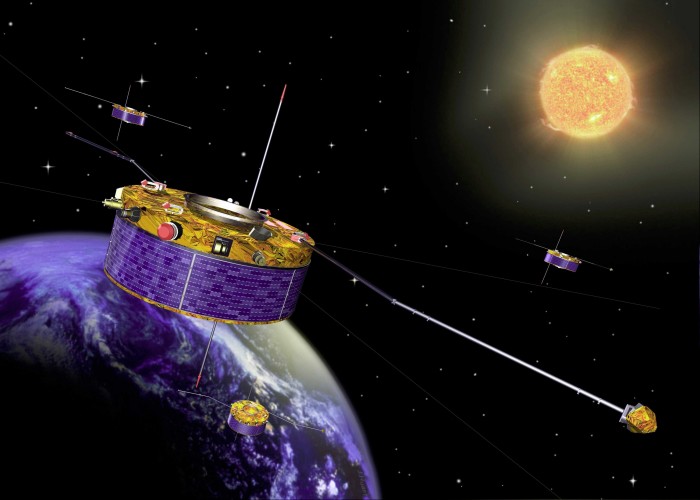The solar wind breaks through the Earth’s magnetic field

The study has been carried out with data from the four Cluster satellites Image: ESA
Researchers at the Swedish Institute of Space Physics (IRF) in Uppsala now have an answer to one of the questions about how this actually occurs.
When two areas with plasma (electrically charged gas) and magnetic fields with different orientations collide, the magnetic fields can be “clipped off” and “reconnected” so that the topology of the magnetic field is changed.
This magnetic reconnection can give energy to eruptions on the solar surface, it can change the energy from the solar wind so that it then creates aurora, and it is one of the obstacles to storing energy through processes in fusion reactors.
If two colliding regions of plasma have the same density, temperature and strength (but different orientation) of their magnetic fields, symmetrical reconnection begins. Scientists understand much about this process. But more usual in reality is that two regions of plasma have different characteristics, for example when the solar wind meets the environment round the Earth. Daniel Graham at IRF has recently published a detailed study of this asymmetrical magnetic reconnection in Physical Review Letters 112, 215004 (2014).
The study uses data from the four European Space Agency satellites in the Cluster mission, satellites which fly in formation in the Earth’s magnetic field.
“Especially important were measurments with two satellites only a few tens of kilometres from each other, in the region where the solar wind meets the Earth’s magnetic field,” says Daniel Graham. “We can thus do detailed measurements to understand plasma physics at a height of 60,000 km.”
Heating of electrons parallel to the magnetic field in conjunction with magnetic reconnection is of especial interest.
“We believe that this is an important piece of the puzzle for understanding how magnetic reconnection works, how charged particles are accelerated, and how particles from different regions can be mixed with each other,” says Daniel Graham. “Our detailed measurements in the Earth’s magnetic field can be used to understand the physics even in fusion reactors on Earth, and in far distant regions in space that we can’t reach with satellites.”
Picture: The study has been carried out with data from the four Cluster satellites (Image: ESA)
More information:
Daniel Graham, postdoctoral fellow at IRF, tel. +46-18-471 5927, dgraham@irfu.se
Mats André, Professor at IRF, tel. +46-18-471 5913, mats.andre@irfu.se
Rick McGregor, pressofficer, +46-980 791 78, rick@irf.se
The Swedish Institute of Space Physics (IRF) is a governmental research institute which conducts research and postgraduate education in atmospheric physics, space physics and space technology. Measurements are made in the atmosphere, ionosphere, magnetosphere and around other planets with the help of ground-based equipment (including radar), stratospheric balloons and satellites. IRF was established (as Kiruna Geophysical Observatory) in 1957 and its first satellite instrument was launched in 1968. The head office is in Kiruna (geographic coordinates 67.84° N, 20.41° E) and IRF also has offices in Umeå, Uppsala and Lund.
http://journals.aps.org/prl/abstract/10.1103/PhysRevLett.112.215004 Article in Physical Review Letters
http://www.space.irfu.se/ Research programme Space Plasma Physics at IRF
Media Contact
All latest news from the category: Physics and Astronomy
This area deals with the fundamental laws and building blocks of nature and how they interact, the properties and the behavior of matter, and research into space and time and their structures.
innovations-report provides in-depth reports and articles on subjects such as astrophysics, laser technologies, nuclear, quantum, particle and solid-state physics, nanotechnologies, planetary research and findings (Mars, Venus) and developments related to the Hubble Telescope.
Newest articles

Bringing bio-inspired robots to life
Nebraska researcher Eric Markvicka gets NSF CAREER Award to pursue manufacture of novel materials for soft robotics and stretchable electronics. Engineers are increasingly eager to develop robots that mimic the…

Bella moths use poison to attract mates
Scientists are closer to finding out how. Pyrrolizidine alkaloids are as bitter and toxic as they are hard to pronounce. They’re produced by several different types of plants and are…

AI tool creates ‘synthetic’ images of cells
…for enhanced microscopy analysis. Observing individual cells through microscopes can reveal a range of important cell biological phenomena that frequently play a role in human diseases, but the process of…





















